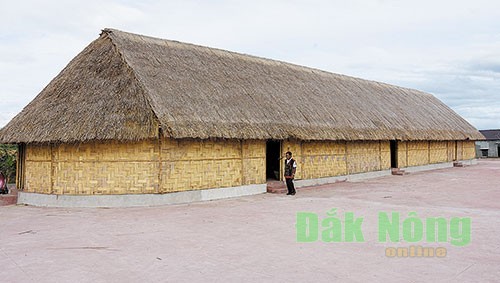(VOVWORLD) - In the Central Highlands province of Dak Nong the traditional cultures of several ethnic minorities, including the M'Nong, converge. The M'Nong, one of the oldest ethnic groups in this region, continue to preserve their customs, festivals, lifestyle, and traditional long house.
 The long house of the M'Nong is as long as 100 meters. (photo: baodaknong.org.vn) The long house of the M'Nong is as long as 100 meters. (photo: baodaknong.org.vn) |
The M’Nong live mainly in Gia Nghia city and the districts of Dak Mil and Tuy Duc, in hamlets of about 10 households of individuals related by blood.
Some M’Nong live in stilt houses. Others live in one-story houses with a thatched, curved roof and a wood and bamboo frame. They prefer to build their houses on flat ground near a spring or river. When a couple marries, rooms are extended on either side of the main compartment of a long house, which may reach a length of 100 meters and accommodate 5 to 10 households.
Each household has its own sleeping compartments, granary, and shed and must manage its own assets. The M’Nong say their long houses have many advantages: minimizing construction costs, making it easier and safer to go from one household to another in the rainy season, and allowing family members living under one roof to help each other when necessary. The grand-parents live in the main apartment in the center, and their off-spring live in connected apartments on either side.
Mr. Y Phot, who lives in Sa Pa hamlet in Thuan An village, talked to VOV about his long-house, “Each apartment has 2 or 3 doors. The main door is for going in and out to work and for welcoming guests. The left-side door is used to go out to feed domestic fowls and animals, and carry water in to the kitchen for cooking. The right-side door is for going out to interact with neighbors.”
The long house of the M’Nong embodies their lifestyle, customs, and beliefs. Like other ethnic groups in the Central Highlands, the M’Nong build their houses in a north-south direction to catch the wind and avoid direct sunshine.
 A woodstove for men. (Photo: baodaknong.org.vn) A woodstove for men. (Photo: baodaknong.org.vn) |
Each apartment has the same design: a granary above the kitchen and a sleeping area on either side of the house. The granaries are connected to each other. On either side of the granary are large baskets of rice stored for a rainy day. There are two woodstoves, one for men and guests, the other for women. Household utensils are arranged in an orderly fashion: gongs hung above the ornamental jars; bags of personal belongings hung on the house pillars; valuables stored in papooses above the sleeping area of the grandparents and parents; rice mortars and pestles kept just outside the side-doors; baskets and papooses hung above the woodstoves.
When you enter a M'Nong long house, you’ll notice liquor jars of different sizes. Tran Thi Van, Deputy Director of the Dak Nong Provincial Museum, says the number of jars in a house indicates the family’s wealth.
“These jars are closely associated with M’Nong history, festivals, and rites. The M’Nong don’t make the jars. They buy them or barter domestic animals for them,” Mrs. Van said.